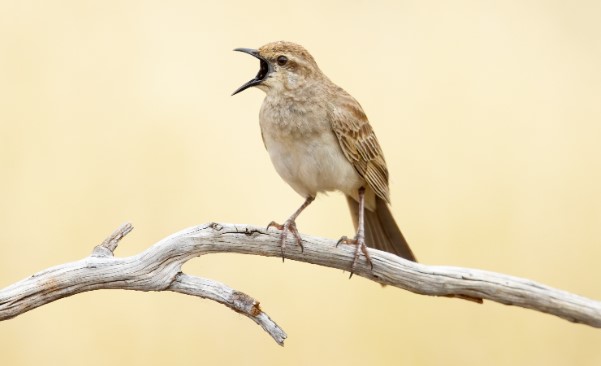The rufous songlark belongs to the family Locustellidae, which includes grass warblers and grassbirds. In August–September, rich but grinding metallic reels signal the arrival of Rufous Songlark in well-grassed woodland across southern Australia. It is also known as the Rufous Singing Lark, red-rumped song lark, rufous singing lark, and skylark. They migrate north from central-northern Queensland to the Kimberleys in late summer and early winter.
There may be some birds left behind. There is little breeding north of the Tropic of Capricorn. During the day, males establish and defend breeding territories with frequent song flights. From high, exposed branches, atop posts, or even from rock projections, these are launched around the territory from different vantage points.

Read More – Ashy-crowned sparrow lark
Fluttering and circling, the bird flies from one perch to another, singing continuously when in the air and intermittently when perched. There is no cocking of the tail and it flies horizontally instead of climbing trees as the Brown Songlark does. Female breeding birds keep under cover of grass, build nests, incubate, and feed their young unobtrusively as males. The size of the male bird is 180–190 mm, whereas the female bird measures 160–170 mm in length.
There is a variation in the size of breeding territories based on the season, with each pair occupying half a hectare to five hectares. The Rufous Songlark nests in grass clumps or on fallen logs on the ground. During the breeding season, all birds are silent and forage alone or in dispersed groups, weaving unobtrusively between tussocks to glean seeds and insects. Dashing undulations are characteristic of flight.
The rufous songlark’s call is sharp tik during a harsh scolding rattle. Rufous Songlark song is repeated rich, grinding, metallic wit-cher wit-cher-witchy-weedle with whip-like effect on first syllables, by breeding males on the wing. As the Rufous Songlark perches, it produces a long, clear, falling trill, sometimes ending in an explosive witchy-wheedle.
ADULTS: Both sexes are similar. The upper parts are plain brown, with dark shafts; the rump is rufous. Tail and wing feathers are paler-edged. The eyebrows are pale buff. The underparts are plain grayish white, with dusky spotting on the breast. Their eyes are brown. Bill is flesh-brown; black in breeding male. Feet are flesh-brown. The immature: As adults, breasts are streaked.
Nesting and breeding occur in August-February. Nest is a cup of grass, lined with finer strands, and sometimes hair. It is built into a hollow in the ground, near or under grass tussocks, within thick herbage, and near fallen logs.
The Rufous Songlark lays three or four eggs, pink-white color, covered with dark red spots and freckles, in a zone at the large end; long oval shape, about 23 x 17 mm. Incubation by females only. Rufous Songlark is found in well-grassed woodlands throughout the mainland except for northern Arnhem Land and the Cape York Peninsula, where it is rare.
Read More: The Bar-tailed Desert Lark







